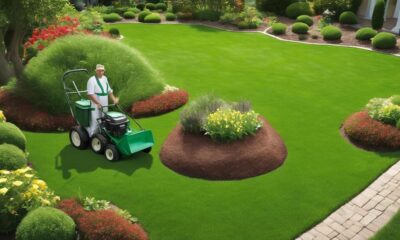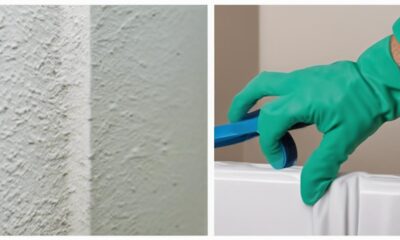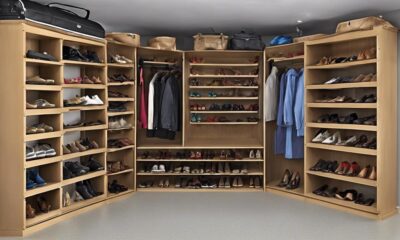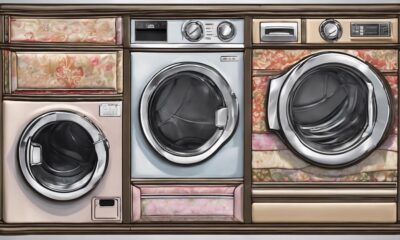Decor
10 Best Interior Design Colleges for Aspiring Designers
Navigate the world of interior design education with the top 10 colleges offering innovative programs and industry connections – discover where your design journey could lead!
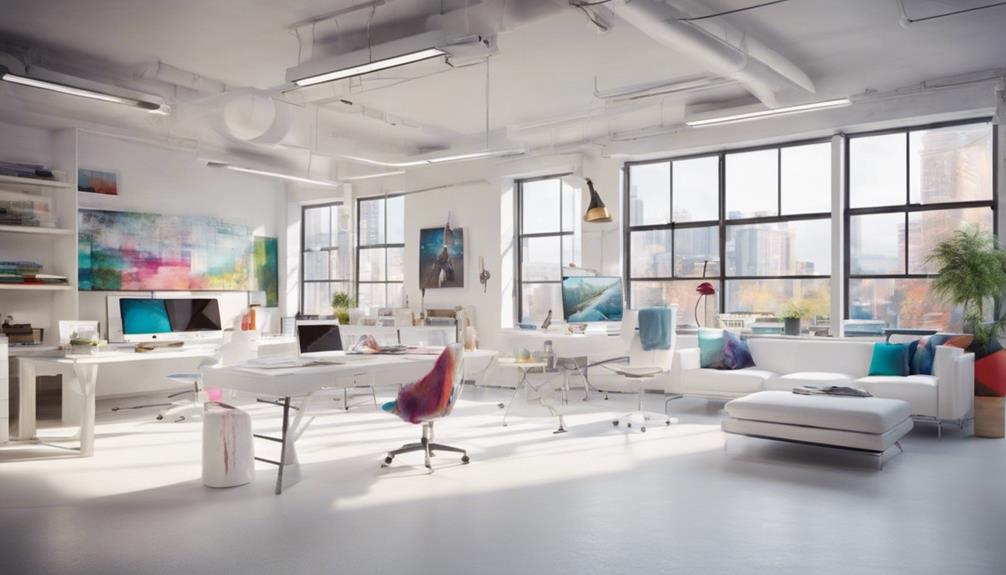
When considering the pursuit of a career in interior design, one may find it beneficial to explore the opportunities presented by the top institutions in the field.
These colleges offer a blend of theoretical knowledge and practical skills that equip students with the tools needed to thrive in the competitive design industry.
By examining the innovative programs and industry connections of these esteemed institutions, aspiring designers can gain valuable insights into the world of interior design education and professional development.
Key Takeaways
- Top interior design colleges offer CIDA accreditation and diverse degree programs.
- Strong industry connections and internships enhance students' career prospects.
- Focus on research, innovation, and practical skills development in interior design programs.
- Emphasis on hands-on experience, industry partnerships, and theoretical knowledge for success.
Savannah College of Art and Design
As experts in the field, we highly recommend considering the Savannah College of Art and Design for aspiring interior designers due to its top ranking and accreditation by CIDA. SCAD offers a range of programs including BFA, MA, and MFA programs in interior design, providing students with a thorough education that emphasizes both theoretical knowledge and practical skills. One of the standout features of SCAD is its remarkable job placement rate for interior design graduates, showcasing the school's commitment to preparing students for successful careers in the industry.
Additionally, SCAD stands out for its dedication to industry innovations and fostering a culture of experimentation within the field of interior design. The institution provides students with hands-on access to cutting-edge technologies and design trends, allowing them to stay ahead of the curve in an ever-evolving industry. SCAD's strong industry connections further enhance the learning experience, offering students valuable networking opportunities that can pave the way for future success in the field.
The New School, Parsons School of Design
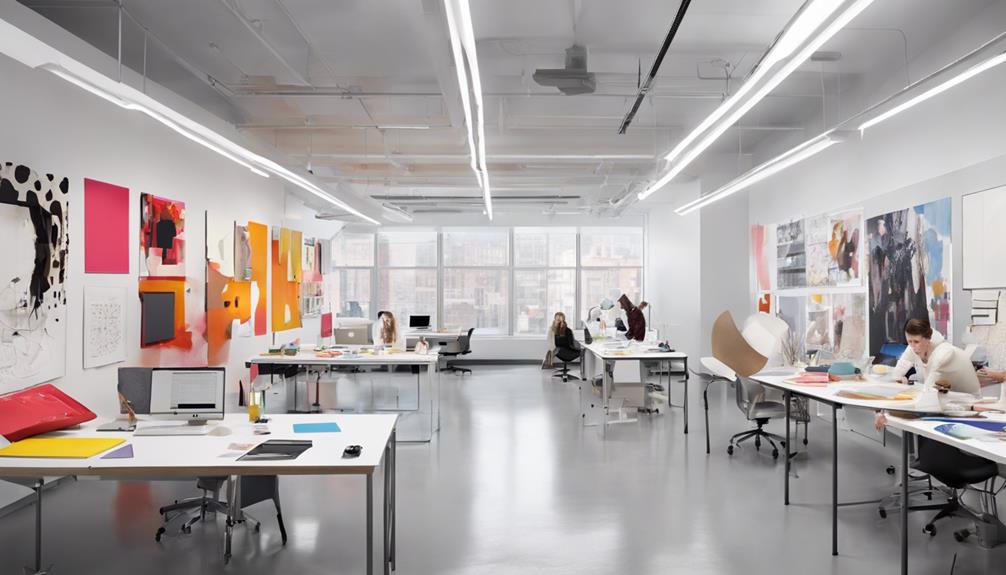
Highly regarded for its pioneering role in establishing the first interior design curriculum in the US, The New School, Parsons School of Design offers a thorough range of programs emphasizing sustainability, diversity, and innovation. Parsons provides a unique educational experience through its BFA, MFA, and AAS programs tailored to nurture creativity and critical thinking in aspiring designers. The school's strategic location in NYC grants students unparalleled access to industry innovations and a robust alumni network, facilitating networking and mentorship opportunities.
- Hands-On Learning: Parsons encourages students to engage in collaborative projects, providing a platform to explore and experiment with new ideas.
- Real-World Preparation: The emphasis on real-world design challenges equips students with practical skills and knowledge crucial for successful careers in the industry.
- Innovative Curriculum: Parsons' programs are designed to foster sustainability and innovation, preparing students to tackle contemporary design challenges.
- Alumni Network: The strong alumni network in NYC offers valuable connections and insights, enhancing students' professional growth and opportunities.
Cornell University
At Cornell University, we've seen first-hand that the top-notch design curriculum sets the stage for a dynamic learning experience.
Our industry connections have opened doors to valuable internships that provide practical insights into the field.
With a focus on innovation, Cornell University equips students with the skills needed to tackle diverse design challenges.
Top-Notch Design Curriculum
Within Cornell University's College of Human Ecology lies a distinguished STEM-certified interior design program known for its top-notch design curriculum. Here are four key aspects that make Cornell's interior design program stand out:
- Specializations: Students can focus on design innovation, sustainability, or health, allowing for in-depth exploration of these critical areas.
- Advanced Study Options: Cornell offers graduate and doctorate programs in interior design, providing opportunities for further specialization and research.
- Interdisciplinary Training: Emphasis on interdisciplinary training equips students to tackle diverse design challenges effectively.
- Research and Innovation: Cornell's program stands out for its strong focus on research and innovation, making it a top choice for those seeking a cutting-edge design education.
Industry Connections and Internships
With a robust network of industry connections and internship opportunities, Cornell University's interior design programs offer students invaluable real-world experiences to enhance their design education. Through collaborations with design firms and professionals, students have the chance to secure internships with renowned companies, gaining hands-on learning experiences and networking with industry experts.
These industry partnerships not only provide practical exposure but also enhance students' career prospects in the design field. By immersing themselves in real-world projects and working closely with industry mentors, students at Cornell University develop a strong foundation for success in the competitive design industry.
The combination of academic rigor and practical industry connections sets students up for a promising future in the dynamic world of design.
New York School of Interior Design
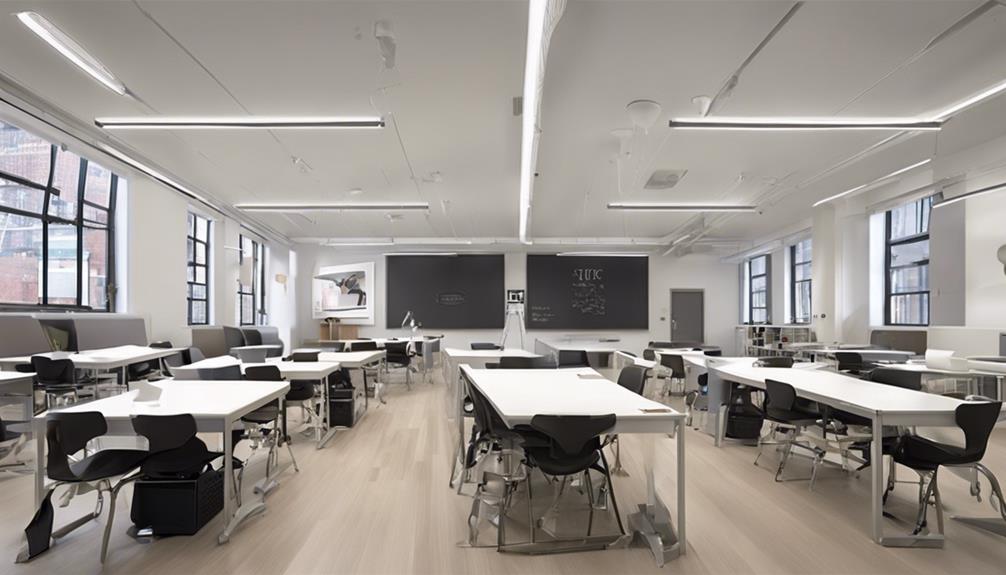
Nestled in the vibrant city of New York, the New York School of Interior Design stands out as a reputable institution for aspiring designers seeking a thorough education in interior design. Here are some key aspects that make this school a top choice for those passionate about the field:
- CIDA Accreditation: The New York School of Interior Design is accredited by CIDA, ensuring that students receive a top-notch education that meets industry standards.
- Acceptance Rate and Competitive Admissions: With an acceptance rate of 30%, the school attracts a diverse student body through a competitive admissions process, fostering a dynamic learning environment.
- Affordability: The net price of $9,809 makes this institution an affordable option for aspiring designers looking to pursue their passion without breaking the bank.
- SAT Score Range: Students aiming for an SAT score between 1300-1470 will find themselves in good company at this esteemed institution, where academic excellence is encouraged and nurtured.
The New York School of Interior Design not only equips students with practical skills but also provides valuable industry connections, setting them on a path towards a successful career in interior design.
Syracuse University
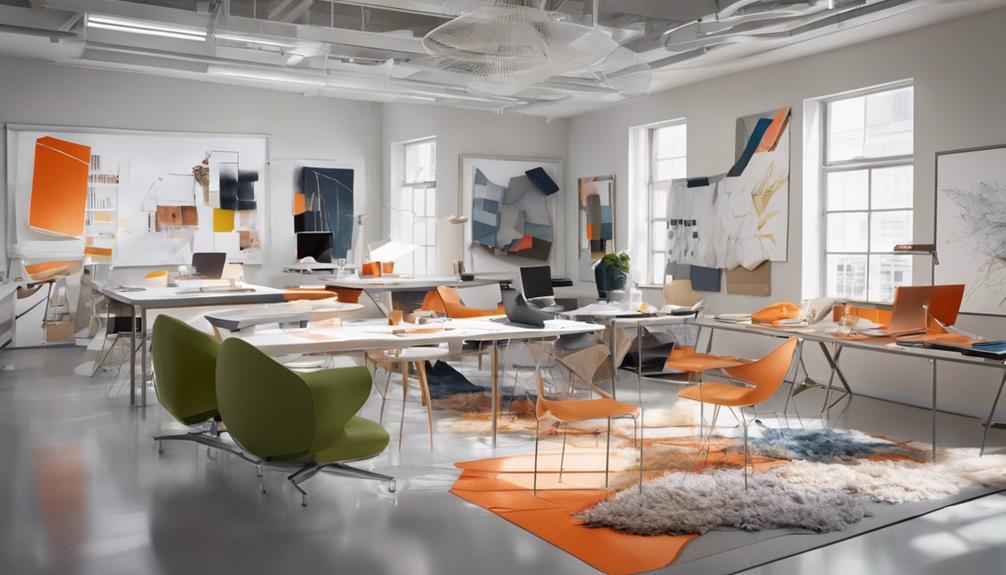
Syracuse University, renowned for its BFA and MFA programs in interior design, offers a rich environment that fosters research, innovation, and collaboration with industry partners. Students at Syracuse University explore the world of interior design through a curriculum that emphasizes not only creativity but also cutting-edge research and innovation in design concepts.
The university stands out for its commitment to providing real-world experience by engaging students in collaborative projects with industry partners, giving them a taste of what awaits them in the professional domain.
Moreover, Syracuse University offers exhibition opportunities through access to the Sue and Leon Genet Gallery, allowing students to showcase their work and gain valuable exposure. Graduates from Syracuse University's interior design programs have gone on to make significant contributions to the field, with notable alumni like Thom Filicia and Stephen Burks leaving their mark on the industry.
This strong alumni network serves as an inspiration and a proof of the quality education provided by Syracuse University.
Drexel University
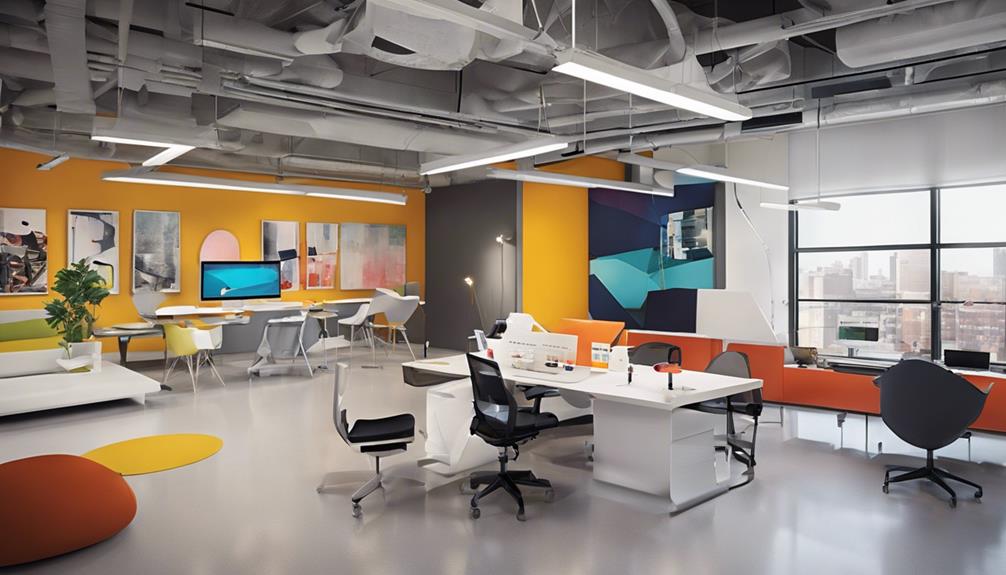
Drexel University, a prominent institution within the Antoinette Westphal College of Media Arts & Design, offers a thorough interior design program that integrates design theory with practical industry experience. At Drexel University, students benefit from a curriculum that emphasizes real-life experience and collaborative professional development.
The program also includes a minor in Sustainability in the Built Environment, reflecting the university's commitment to sustainable design practices. Moreover, students undertake a senior project as part of their undergraduate studies, providing them with valuable hands-on experience and enhancing their design portfolios.
Through Drexel University's interior design program, students develop practical skills and establish industry connections that set them up for success in the competitive field of interior design. The university's focus on combining theoretical knowledge with practical application ensures that graduates are well-prepared to tackle the challenges of the industry with creativity and innovation.
Fashion Institute of Technology

As we shift our focus to the Fashion Institute of Technology, situated in New York, we encounter a prestigious institution known for its diverse array of interior design programs. FIT offers Associate of Applied Science (AAS), Bachelor of Fine Arts (BFA), and Master of Fine Arts (MFA) programs in interior design, emphasizing practical skills crucial for a successful career in the field. One of FIT's distinguishing features is its strong industry partnerships, providing students with valuable networking opportunities and real-world experiences.
Notable alumni from FIT include iconic designers such as Calvin Klein and Michael Kors, showcasing the caliber of talent fostered at the institution. Students at FIT benefit from access to the Museum at FIT, a rich resource for design inspiration and research. The programs at FIT are designed to prepare students for internships and job placements, ensuring they're well-equipped to thrive in the competitive world of interior design. With its innovative approach and esteemed alumni, FIT stands out as a top choice for aspiring interior designers looking to make their mark in the industry.
University of Cincinnati
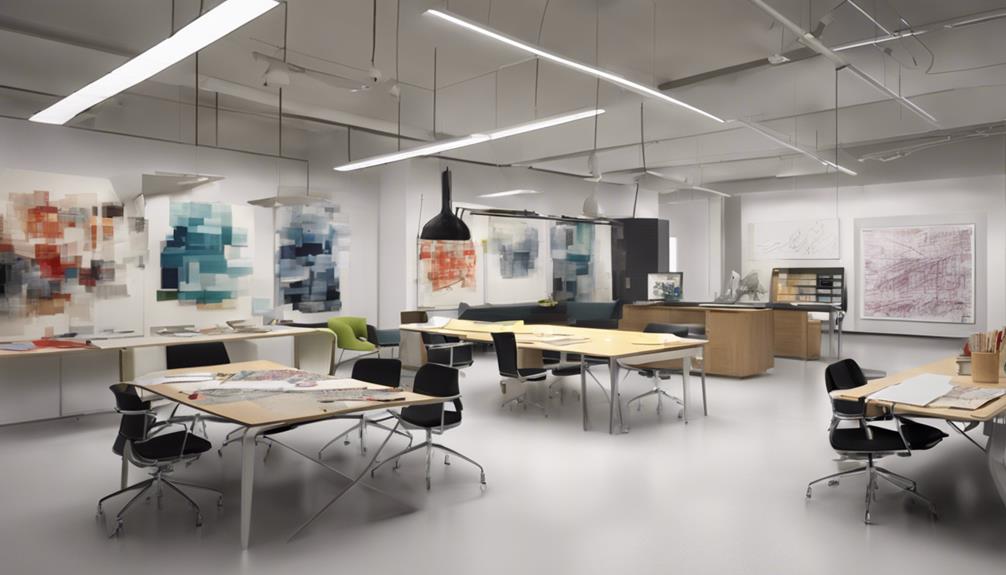
At the University of Cincinnati, our interior design programs offer a wide range of degrees, focusing on research and innovation to prepare students for success in the field. Here are some key highlights about our program:
- Diverse Degree Options: We provide BAA, MA, and PhD programs in interior design, catering to students at various stages of their academic journey.
- Emphasis on Research and Innovation: Our curriculum places a strong emphasis on research and innovation, equipping students with the skills needed to thrive in a dynamic industry.
- Industry Partnerships: Through collaborative projects with industry partners, students gain valuable real-world experience and insights, preparing them for the demands of the professional world.
- Aronoff Center for Design and Art: Our students have access to the state-of-the-art Aronoff Center for Design and Art, a hub of creativity and inspiration, enhancing their learning experience.
Notable alumni such as Thom Mayne and Dale Chihuly exemplify the success that can stem from our rigorous and innovative interior design programs at the University of Cincinnati.
Rhode Island School of Design
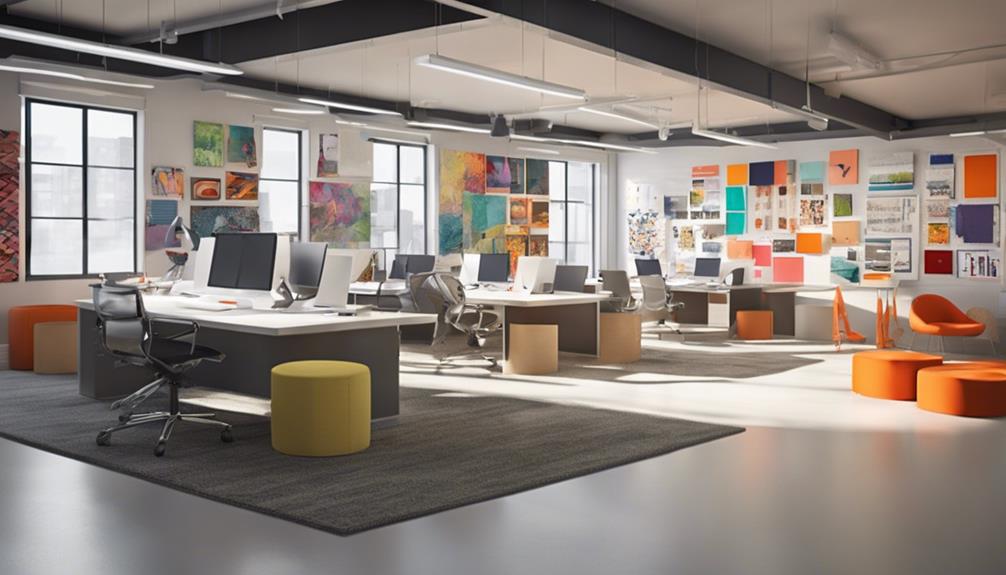
With its focus on studio work and hands-on experience, Rhode Island School of Design (RISD) offers extensive BFA and MFA programs tailored to aspiring interior designers. At RISD, experimentation and risk-taking aren't only guaranteed but celebrated, fostering a culture of creativity and innovation among students. The school provides access to inspiring resources like the RISD Museum and Nature Lab, enriching the design process with diverse influences and research opportunities.
RISD stands out for its notable alumni, including renowned designers such as Nicole Miller, James Mont, and Robert Geller, who've made significant contributions to the world of interior design. By emphasizing practical skills and hands-on experience, RISD guarantees that its students are well-prepared for successful careers in the industry. The combination of theoretical knowledge and real-world application sets RISD graduates apart in the competitive field of interior design.
Kansas State University
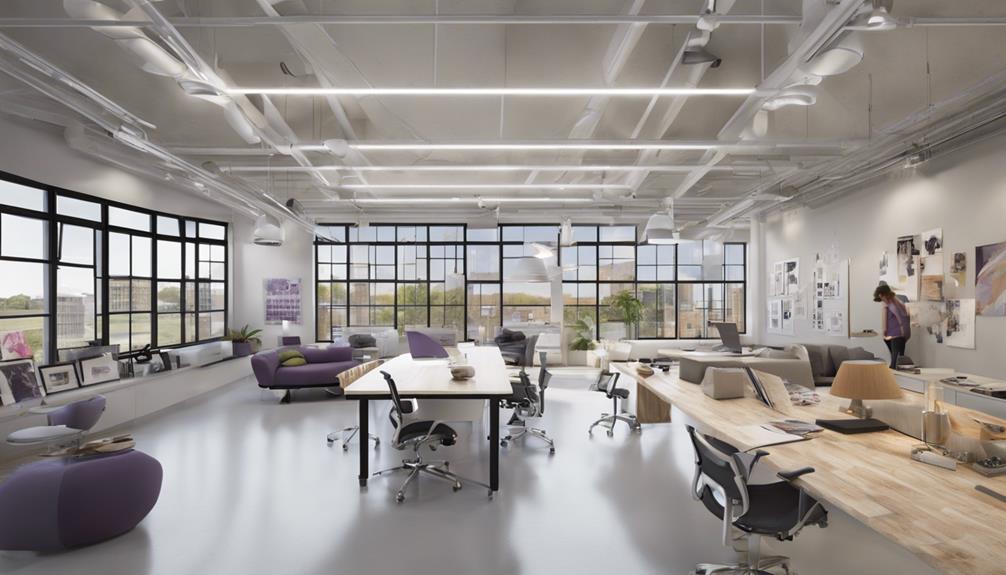
Aiming for excellence in interior design education, Kansas State University offers a Bachelor of Science program tailored to aspiring designers. The program stands out for its emphasis on hands-on experience and practical skills development, providing students with a thorough learning experience.
Here are four key aspects that make Kansas State University a top choice for those pursuing a career in interior design:
- Supportive Learning Environment: Situated in Manhattan, Kansas, the university creates a conducive atmosphere for students to thrive and unleash their creativity in the field of interior design.
- Accreditation: The program is accredited by the Council for Interior Design Accreditation (CIDA), ensuring that students receive a high-quality education that meets industry standards.
- Career Preparation: Kansas State University's interior design program equips students with the necessary skills and knowledge to pursue diverse career opportunities in the field, preparing them for a successful career ahead.
- Diverse Opportunities: By offering a robust curriculum, the university opens doors to a wide range of career paths within the interior design industry, empowering students to explore various avenues for their future endeavors.
Frequently Asked Questions
What Is the Best College to Major in Interior Design?
When considering the best college for a major in interior design, it's important to evaluate factors like accreditation, curriculum depth, faculty expertise, and industry connections. These elements can greatly impact one's educational experience and future opportunities.
Which University Is Best for Interior Design?
We believe the best university for interior design is subjective and depends on individual preferences. Factors such as location, curriculum, faculty, and facilities play an important role in determining the ideal fit for aspiring designers.
Which Institute Is Best for Interior Design?
Well, let me tell you, finding the best institute for interior design can be a real adventure. But fear not, we're here to guide you through the maze of options and help you find your perfect fit.
Which Degree Is Best for Interior Design?
For interior design, a Bachelor of Interior Design (BID) is ideal. It provides necessary skills and knowledge. Specialized degrees like BS or BFA in Interior Design offer different focuses. Consider CIDA-accredited programs and industry relevance for the best fit.
Conclusion
As we wrap up our exploration of the top interior design colleges, it's clear that the future of design is in good hands.
From the collaborative projects at Savannah College of Art and Design to the innovative programs at Parsons, The New School, these institutions are shaping the next generation of designers.
With a focus on creativity, industry connections, and hands-on experience, these colleges provide the perfect foundation for aspiring designers to thrive and make their mark in the world of interior design. Students interested in exploring interior design major colleges will find programs that emphasize both artistic vision and practical skills essential for success in the field. These institutions often offer state-of-the-art facilities, mentorship from accomplished professionals, and opportunities for internships that bridge education and real-world experience. By combining innovation with a deep understanding of design principles, graduates are well-equipped to tackle diverse challenges and build impactful careers.
- About the Author
- Latest Posts
Introducing Ron, the home decor aficionado at ByRetreat, whose passion for creating beautiful and inviting spaces is at the heart of his work. With his deep knowledge of home decor and his innate sense of style, Ron brings a wealth of expertise and a keen eye for detail to the ByRetreat team.
Ron’s love for home decor goes beyond aesthetics; he understands that our surroundings play a significant role in our overall well-being and productivity. With this in mind, Ron is dedicated to transforming remote workspaces into havens of comfort, functionality, and beauty.
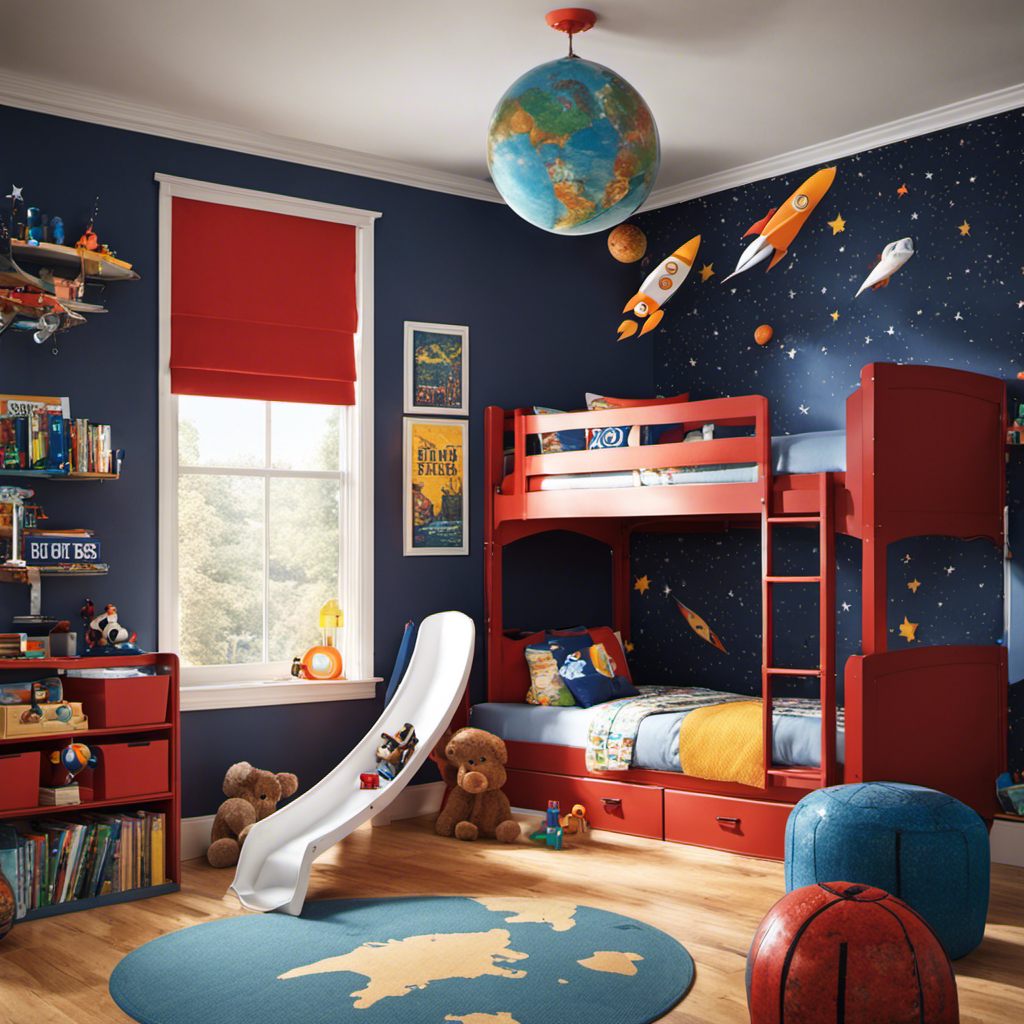
Have you ever considered that a thoughtfully designed and customized space can greatly influence a boy’s growth and joy? By incorporating some creativity and a bit of expertise, you can craft the ideal sanctuary for your child.
In this article, I’ll guide you through the process of building boys room decor, from choosing the theme and color scheme to selecting furniture and adding personalized touches.
Get ready to transform your son’s space into a place where he can dream, play, and grow.
Key Takeaways
- Consider the boy’s interests and preferences for the theme
- Utilize multi-purpose furniture and storage solutions
- Personalize walls with DIY wall decor using child’s artwork or repurposed items
- Incorporate personalized touches to make the room truly their own
Choosing the Theme
When choosing the theme for your boy’s room decor, it’s important to consider his interests and preferences.
Bedding options and lighting fixtures play a crucial role in creating a cohesive and inviting space. For bedding, you can opt for fun patterns like superheroes, sports, or animals, which can bring his favorite characters or hobbies to life. Complement the bedding with coordinating curtains and throw pillows to add depth and texture.
Lighting fixtures can contribute to the overall ambiance of the room. Consider installing a ceiling fan with built-in lights or a desk lamp for reading and studying. By selecting bedding options and lighting fixtures that align with your boy’s interests, you can create a personalized and comfortable space.
Now, let’s move on to selecting the right color scheme, which will further enhance the room’s aesthetic appeal.
Selecting the Right Color Scheme
Choosing the perfect color scheme for your little guy’s space is essential in creating a cohesive and inviting atmosphere. When it comes to selecting the right colors for a boy’s room, considering color psychology can be helpful.
Blue, for example, is known for its calming and soothing effects, perfect for creating a serene environment. Green is another great choice, as it promotes a sense of harmony and balance.
To add a pop of personality to the room, consider accent wall options. Whether it’s a bold stripe, a geometric pattern, or a superhero-themed mural, an accent wall can instantly transform the space and add visual interest.
Now that we’ve covered the importance of color, let’s move on to exploring furniture and storage solutions that will help maximize your little one’s space.
Furniture and Storage Solutions
Now that we’ve covered the importance of color, let’s take a look at some furniture and storage solutions that will help maximize your little one’s space.
When it comes to furniture arrangement, here are three organization hacks that will make a big difference in your boy’s room:
-
Utilize multi-purpose furniture: Opt for a loft bed with built-in storage or a desk with drawers. These pieces will provide functionality without taking up extra space.
-
Use vertical storage: Install floating shelves or wall-mounted bookcases to free up floor space. You can also hang hooks or pegboards to keep hats, bags, and other accessories neatly organized.
-
Invest in storage bins and baskets: These versatile containers are perfect for storing toys, clothes, and other belongings. Label them for easy identification and teach your child the importance of tidiness.
By implementing these furniture and storage solutions, you’ll create a more organized and spacious room for your little one.
Now, let’s move on to some DIY wall decor ideas that will add a personal touch to the space.
DIY Wall Decor Ideas
There are many creative and budget-friendly ways to personalize the walls in your child’s space. One of my favorite ways to add a personal touch is through DIY wall art. You can create unique and meaningful pieces by using your child’s artwork, photographs, or even repurposing old items. Get creative with materials like canvas, wood, or even fabric to make stunning wall decor that reflects your child’s interests and personality.
Another fun option is to use creative wall decals. These removable stickers come in various designs and can be easily applied and removed without damaging the walls. They are perfect for adding a pop of color or a whimsical touch to your child’s room. You can find an array of options online or even make your own using printable designs or stencils.
Adding Personalized Touches
You can easily personalize your child’s space by incorporating their artwork or photographs into DIY wall decor. It’s a simple and meaningful way to showcase their creativity and make their room truly their own.
Here are three ideas to inspire you:
-
Create a gallery wall: Gather your child’s artwork and frame it in coordinating frames. Arrange the frames on the wall to create a gallery-style display. This will not only add a personal touch to the room but also serve as a conversation starter when guests come over.
-
Custom wall decals: Design and create custom wall decals using your child’s favorite quotes, sayings, or drawings. You can find online services that allow you to upload your designs and have them turned into decals. Apply them to the walls to add a unique touch to the room.
-
Personalized bedding: Choose bedding that reflects your child’s interests and personality. Look for options that can be personalized with their name or initials. This will not only make their bed feel special but also add a personalized touch to the entire room.
Frequently Asked Questions
How Can I Incorporate Educational Elements Into My Boy’s Room Decor?
Incorporating learning tools into my boy’s room decor is a great way to make it educational. By adding interactive wall art, a reading nook, and organizing bedtime routine essentials, his room becomes a fun and educational space.
What Are Some Budget-Friendly Options for Furniture and Storage Solutions?
When it comes to designing a boy’s room, finding budget-friendly furniture options and creative storage solutions is key. Let me share some ideas that will help you create a stylish and functional space without breaking the bank.
Are There Any Tips for Creating a Cohesive Color Scheme While Still Allowing for Personalization?
Creating a personalized color palette while finding balance between style and personalization is key. Start by selecting a base color and then adding accent colors that reflect your child’s interests. Don’t be afraid to mix and match patterns and textures for added visual interest.
Can You Recommend Any Unique DIY Wall Decor Ideas That Are Easy to Execute?
Sure, I can recommend some unique DIY wall decor ideas that are easy to execute. From creating a gallery wall with vintage record covers to crafting geometric wall art with washi tape, the options are endless!
How Can I Create a Space That Will Grow With My Son’s Changing Interests and Preferences Over Time?
To create a space that grows with my son’s changing interests, I focus on creating personalized artwork and incorporating interactive elements. This allows for flexibility and ensures that the room can easily adapt to his evolving preferences over time.
Can Wood Quilt Decor Ideas Be Incorporated into Boys Room Decor?
Yes, wood quilt decor tutorial can be incorporated into boys room decor to add a rustic and cozy touch. Using wooden quilted wall art, shelves, or even a wooden quilt-inspired headboard can bring warmth and texture to the room. The natural elements of wood complement the rugged and adventurous theme of a boys room.
Conclusion
In conclusion, building a boy’s room decor is a creative and detail-oriented process. It requires careful consideration of the theme, color scheme, furniture, and personalized touches.
With the right combination of elements, you can create a space that reflects your child’s personality and interests. Whether it’s a sports-themed room or a space-inspired design, allowing your imagination to run wild will result in a room that not only looks great but also provides a cozy and comfortable environment for your little one.
So, embrace your inner designer and let the rhythm of your creativity guide you in creating a room that will make your child’s dreams come true.
- About the Author
- Latest Posts
Meet Bethia, the visionary designer at ByRetreat who brings a touch of magic to every remote workspace she creates. With a boundless imagination and an eye for beauty, Bethia is passionate about transforming ordinary spaces into extraordinary havens of creativity and comfort.
Bethia possesses a unique talent for envisioning the perfect combination of furniture, colors, and textures that harmonize seamlessly in a room. She understands that selecting furniture goes beyond mere functionality; it’s about curating pieces that evoke a sense of style and sophistication while enhancing the overall ambiance.
Architecture Home Styles
What Are the Differences Between Tiny Vs Micro Homes?
Keen to unravel the subtle yet significant contrasts between tiny and micro homes? Discover the fascinating distinctions that go beyond their sizes in this insightful comparison.
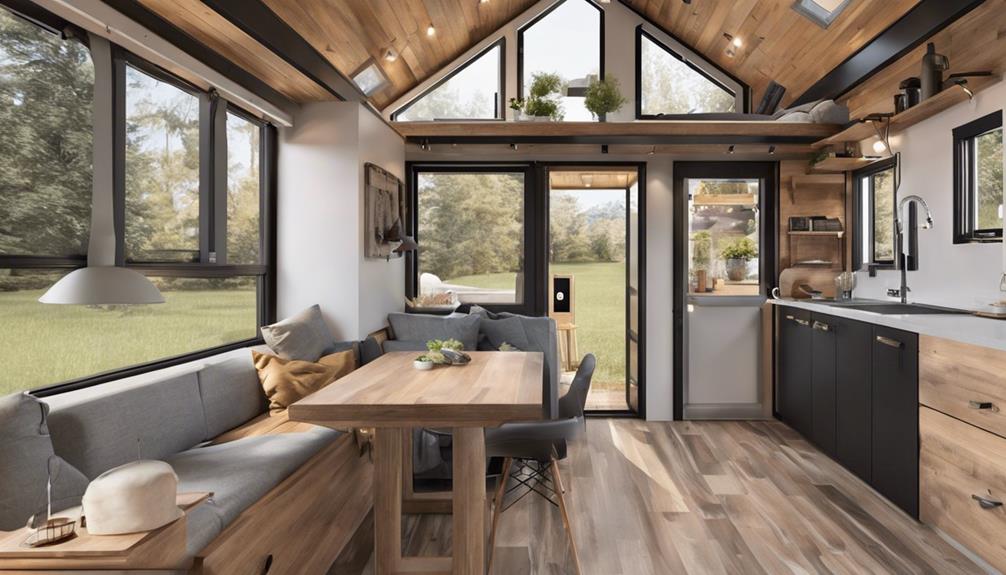
When comparing tiny homes to micro homes, it’s like different shades of a color spectrum; at first glance, they might seem similar, but upon closer inspection, their distinctions become apparent.
The nuances between these compact living spaces go beyond mere square footage. Let's explore how size, mobility, cost, design, and environmental factors play into the choice between tiny and micro homes.
Key Takeaways
- Tiny homes are smaller (under 400 sq ft) and focus on minimalism.
- Micro homes offer more space (400-800 sq ft) and additional amenities.
- Micro homes cost more ($40,000-$80,000) due to size and amenities.
- Tiny homes prioritize mobility, while micro homes balance functionality and style.
Size and Square Footage Variances
When comparing tiny homes to micro homes, the key distinction lies in their size and square footage variances. Tiny homes typically measure under 400 square feet, emphasizing minimalism and compact living.
In contrast, micro homes range from 400 to 800 square feet, offering more space for amenities such as bathrooms, kitchens, and porches. The extra square footage in micro homes allows for a more comfortable living experience compared to tiny homes.
This difference in size impacts the overall livability and functionality of the house, with micro homes providing a slightly larger footprint for occupants. While both tiny and micro homes are part of the tiny house movement, micro homes are often seen as an upgrade due to their ability to offer a bit more breathing room within the small house concept.
The choice between tiny and micro homes ultimately depends on individual preferences for space and comfort within the constraints of small living arrangements.
Mobility and Portability Distinctions
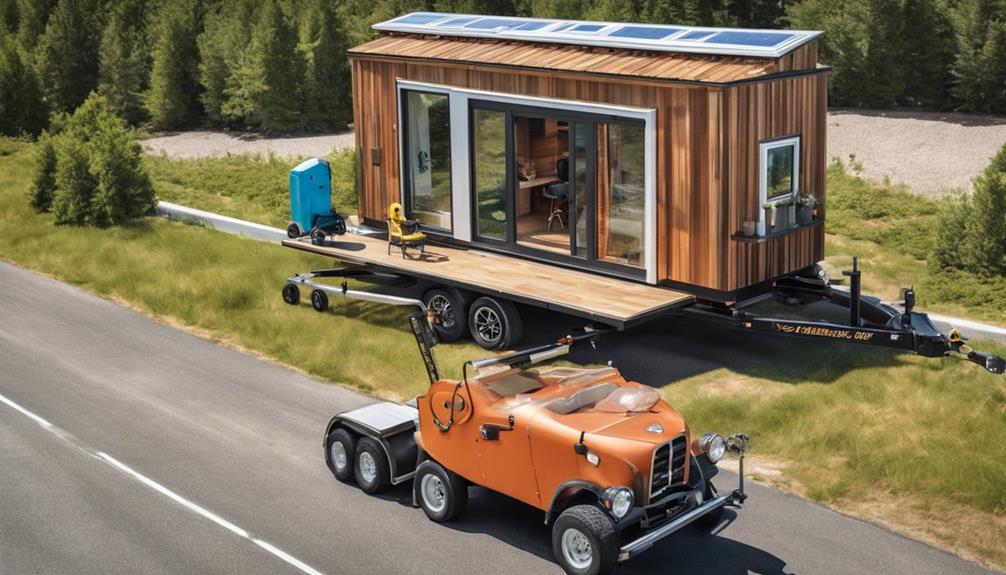
Moving from the discussion on size and square footage variances between tiny and micro homes, an important aspect to consider is the distinctions in mobility and portability features of these compact living spaces. Tiny homes are often constructed with wheels, allowing for easy relocation and travel, catering to individuals seeking a portable lifestyle. On the other hand, micro homes, although slightly larger in size, are also designed with portability in mind, offering the flexibility to move if needed. Both tiny and micro homes provide the freedom to change living environments and embrace a mobile lifestyle.
| Features | Tiny Homes | Micro Homes |
|---|---|---|
| Mobility | Built on wheels for travel | Designed for easy relocation |
| Portability | Emphasis on easy relocation | Offers flexibility to move |
| Flexibility | Allows for changes in location | Can be moved if necessary |
| Lifestyle | Enables a portable lifestyle | Provides a sense of freedom |
| Travel | Ideal for those who value travel | Suited for a mobile lifestyle |
Cost Disparities Between Tiny and Micro Homes
The cost differentials between tiny and micro homes are primarily influenced by factors such as size, materials, and included amenities. Tiny homes typically range from $15,000 to $60,000 to build, making them more budget-friendly compared to micro homes, which can cost between $40,000 to $80,000. This cost disparity is mainly due to the size difference between the two housing options. Micro homes, being larger than tiny homes, require a higher investment but offer more space and features.
In terms of materials, both tiny and micro homes can vary greatly depending on the builder and design choices. However, the larger size of micro homes may necessitate more materials, contributing to the higher overall cost. Additionally, micro homes often come with added amenities such as full kitchens, bathrooms, and living spaces, which can also increase the final price tag. On the other hand, tiny homes are designed to be more compact and minimalist, focusing on essential living spaces to keep costs lower while still providing a comfortable living environment.
Design and Style Contrasts

Considering the distinctive cost disparities between tiny and micro homes, it's essential to explore the contrasting design and style elements that define these two compact living options. Tiny homes often embrace a cozier and more traditional aesthetic, with design choices like pitched roofs, rustic wood finishes, and lofted sleeping areas that maximize vertical space. In contrast, micro homes lean toward sleek, minimalist styles, incorporating cutting-edge technology and innovative layouts with an emphasis on multifunctional furniture. By examining the balance of traditional vs modern house features, one can better understand how these compact living spaces cater to varying tastes, needs, and budgets.
Tiny homes typically embrace a minimalist and modern design approach, focusing on simplicity and functionality. In contrast, micro homes often offer a more spacious layout, providing additional amenities like a porch and a separate bathroom, catering to those seeking a balance between compact living and comfort.
While tiny homes prioritize mobility and efficiency in their design, micro homes strike a balance between functionality and style. Micro homes may also lean towards a more traditional house appearance, contrasting the unique and often unconventional designs found in tiny homes.
Whether one prefers the sleek, contemporary look of tiny homes or the more traditional and spacious feel of micro homes, both options offer innovative solutions for those seeking compact living without sacrificing style or functionality.
Environmental Impact Variances
When examining the environmental impact variances between tiny and micro homes, it becomes evident that their size and resource utilization play a crucial role in determining their eco-friendliness.
Tiny homes have a smaller environmental footprint due to their reduced size and resource consumption. These compact dwellings often use eco-friendly construction materials and incorporate energy-efficient features to enhance sustainability.
In contrast, micro homes, though slightly larger, still prioritize environmental consciousness by utilizing green technologies such as solar panels and rainwater harvesting systems.
Both tiny and micro homes offer options for off-grid living, with tiny homes being more easily adaptable for sustainable practices like solar power and composting toilets. Micro homes strike a balance between eco-friendliness and comfortable living space, attracting those who seek a middle ground between tiny and traditional homes.
Frequently Asked Questions
What Is the Difference Between a Tiny Home and a Micro Home?
When looking at a tiny home versus a micro home, the distinction lies in size and functionality. Tiny homes are typically under 400 square feet, while micro homes range from 400-800 square feet, offering more space and amenities.
While tiny homes are known for affordability and minimalism, micro homes provide a bit more room for comfortable living, often functioning as independent living spaces with their own bathroom and kitchen.
What Classifies as a Tiny Home?
We consider a tiny home as a dwelling that's typically under 400 square feet in size, crafted with the essence of simplicity and functionality. These homes are designed to cater to the needs of a minimalist lifestyle, emphasizing efficiency and sustainability.
In essence, a tiny home symbolizes the liberation from excess, offering a cozy sanctuary that prioritizes mindful living and resourcefulness.
How Big Are Micro Homes?
Micro homes typically range from 400 to 800 square feet, offering more living space than tiny houses. They're designed for independent living and include essential amenities like a bathroom, kitchen, and porch.
Despite their compact size, micro homes are fully functional houses suitable for individuals or couples seeking efficient living spaces. Their layout optimizes every inch, creating a cozy yet practical environment for modern living.
Is 600 Sq Ft Considered a Tiny House?
We believe that 600 square feet is typically considered a small home rather than a tiny house. While tiny houses are usually under 400 square feet, small homes can range up to 1000 square feet.
This size difference impacts the space utilization and features available in the house. Small homes provide more room for comfort and amenities compared to tiny houses, with 600 square feet offering enough space for essential living areas in a small home setting.
Conclusion
In conclusion, the differences between tiny and micro homes are as vast as the ocean and as intricate as a spider's web. From size variations to cost disparities, each type offers a unique living experience tailored to different preferences and needs.
While tiny homes focus on minimalism and affordability, micro homes provide more space and functionality. Both options have their own advantages and drawbacks, but ultimately offer a sustainable and environmentally friendly housing solution for those seeking a simpler lifestyle.
- About the Author
- Latest Posts
Introducing Ron, the home decor aficionado at ByRetreat, whose passion for creating beautiful and inviting spaces is at the heart of his work. With his deep knowledge of home decor and his innate sense of style, Ron brings a wealth of expertise and a keen eye for detail to the ByRetreat team.
Ron’s love for home decor goes beyond aesthetics; he understands that our surroundings play a significant role in our overall well-being and productivity. With this in mind, Ron is dedicated to transforming remote workspaces into havens of comfort, functionality, and beauty.
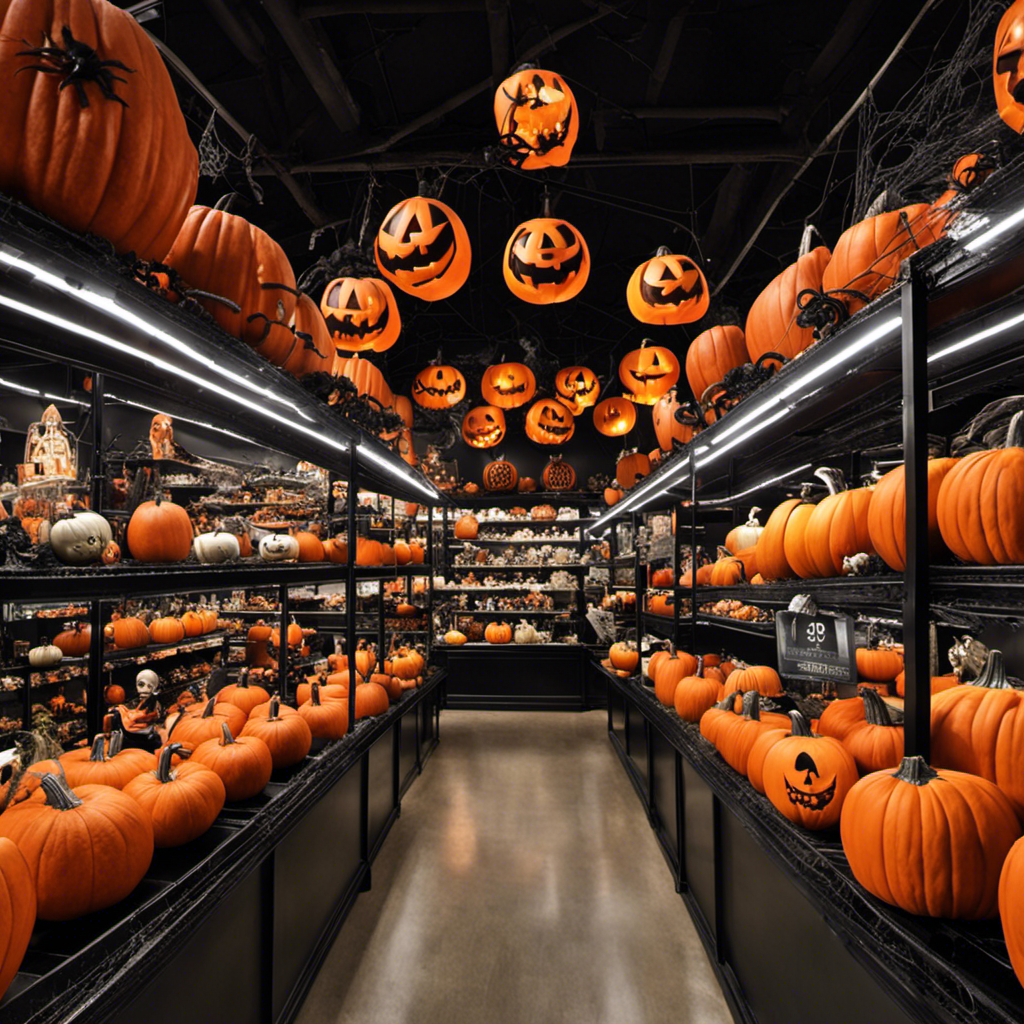
Want to add some spooky vibes to your home this Halloween? Not sure where to find the top Halloween decorations? Look no more! This article will unveil the answer to the question on everyone’s mind: which stores sell Halloween decor?
Whether you prefer to shop online or explore local retailers, I’ve got you covered. From party supply stores to specialty Halloween shops, I’ll provide you with a comprehensive list of the best places to find ghoulish goodies.
So, let’s get started on transforming your home into a haunted haven!
Key Takeaways
- Online retailers offer a wide selection of Halloween decor and provide the convenience of online shopping and price comparison.
- Party supply stores are the go-to destination for creating a spooky atmosphere at home, with a variety of party themes and DIY decoration options.
- Home decor stores, including budget-friendly options like Dollar Tree and Walmart, offer a wide variety of Halloween decor with factors to consider such as quality, variety, and price.
- Big-box retailers like Target and Walmart offer a larger selection and more affordable prices, while specialty stores provide a more unique and specialized selection of Halloween decor.
Online Retailers
You can find a wide selection of Halloween decor from online retailers. These retailers offer unique Halloween decorations that can add a spooky touch to your home.
Whether you’re looking for creepy props, eerie lighting, or hauntingly beautiful decorations, online retailers have it all.
One advantage of shopping online for Halloween decor is the convenience. You can browse through different websites and compare prices without leaving your home.
Another benefit is the availability of DIY Halloween decoration ideas. Many online retailers offer tutorials and inspiration for creating your own decorations, allowing you to personalize your Halloween decor and make it truly unique.
Now, let’s move on to the next section, where we will explore party supply stores and their offerings.
Party Supply Stores
Party supply stores typically have a wide selection of Halloween decorations available. They are a go-to destination for anyone planning a Halloween party or looking to create a spooky atmosphere at home. These stores offer a variety of party themes, allowing customers to choose decorations that match their desired aesthetic.
Additionally, party supply stores often provide DIY decorations, giving customers the opportunity to personalize their Halloween decor. From table centerpieces to hanging bats and skeletons, these stores have everything you need to transform your space into a haunted haven.
However, if you’re looking for a wider range of options and higher-quality items, home decor stores may be a better choice.
Home Decor Stores
When it comes to finding popular Halloween decor stores, there are several options to consider.
From well-known retailers like Party City and Spirit Halloween, to specialty stores like Halloween Express, there are plenty of places to find spooky decorations.
Additionally, online options are available, allowing for convenient shopping and a wider selection.
Lastly, for those on a budget, there are also budget-friendly stores like Dollar Tree and Walmart that offer affordable Halloween decor options.
Popular Halloween Decor Stores
Some of the most popular stores that sell Halloween decor include Spirit Halloween, Walmart, and Target.
When it comes to finding the best online options for unique Halloween decorations, there are a few key factors to consider.
- Quality: Look for stores that offer high-quality products that will last for years to come.
- Variety: Choose a retailer that offers a wide selection of different decorations, from spooky skeletons to cute pumpkins.
- Price: Compare prices across different stores to ensure you’re getting the best deal for your budget.
Now that we’ve explored the popular brick-and-mortar options, let’s dive into the world of online shopping and discover the wide range of options available to us.
Online Options Available
If you’re looking for a convenient way to shop for Halloween decorations, you can explore the wide range of online options available.
Online shopping provides a great opportunity to find unique and creative Halloween decorations without even leaving your home.
One of the advantages of shopping online is the ability to find DIY Halloween decor ideas. Many online retailers offer a variety of do-it-yourself kits and supplies that allow you to create your own spooky decorations.
Another tip for finding unique Halloween decorations online is to browse through specialized websites and marketplaces that focus specifically on Halloween items. These platforms often have a wide selection of one-of-a-kind decorations that you won’t find in traditional stores.
With so many online options available, you’re sure to find the perfect decorations to make your Halloween truly memorable.
Now, let’s move on to budget-friendly stores that offer great Halloween decor options.
Budget-Friendly Stores
After exploring online options for Halloween decor, I realized that there are also plenty of budget-friendly stores that sell affordable options. These stores are perfect for those who prefer DIY decorations or want to save some money while still getting into the spooky spirit. Here are a few options to consider:
-
Dollar stores: They often have a wide range of inexpensive Halloween decorations, from pumpkins and skeletons to spiderwebs and witches hats.
-
Thrift stores: You never know what hidden gems you might find at thrift stores. Look for second-hand Halloween decorations that can be easily repurposed or transformed into something uniquely spooky.
-
Craft stores: Craft stores usually offer a variety of affordable materials that you can use to create your own Halloween decorations, such as foam, paint, and glitter.
Now that we’ve explored affordable options and DIY decorations, let’s move on to the next section about big-box retailers and their Halloween offerings.
Big-Box Retailers
Target and Walmart are popular options for finding Halloween decor at big-box retailers. These stores offer a wide variety of spooky items, from inflatable decorations to creepy lights and everything in between.
When it comes to big box stores versus specialty stores, there are a few key differences to consider. For one, big box stores tend to have a larger selection and more affordable prices. They also offer the convenience of online shopping, allowing you to browse and purchase items from the comfort of your own home.
However, if you prefer the in-store shopping experience and want a more unique or specialized selection, specialty Halloween stores may be the way to go. These stores often have a more extensive range of high-quality and exclusive items, perfect for those looking to create a truly one-of-a-kind Halloween display.
Specialty Halloween Stores
When it comes to finding the best Halloween store, the debate between online and in-store shopping can be a tough one.
Online shopping offers convenience and a wide selection, allowing you to browse through countless options from the comfort of your own home.
However, visiting a physical store can provide a more immersive experience, with the opportunity to see and try on costumes and decorations in person.
Ultimately, the choice between online and in-store shopping for your Halloween needs depends on your personal preferences and what you value most in your shopping experience.
Best Halloween Store
The best Halloween store near me is Spirit Halloween. They have a wide selection of costumes, accessories, and decorations that are perfect for the spooky season. Here are three reasons why Spirit Halloween is the top choice for Halloween enthusiasts:
-
Extensive Variety: Spirit Halloween offers the best Halloween costumes, ranging from classic characters to trendy pop culture references. They have options for all ages and sizes, ensuring that everyone can find their perfect costume.
-
Quality Decorations: Whether you’re looking for DIY Halloween decorations or ready-made items, Spirit Halloween has it all. From creepy animatronics to stylish home decor, their selection is unmatched.
-
Knowledgeable Staff: The staff at Spirit Halloween is friendly and knowledgeable. They can help you find the perfect costume or offer suggestions for creating your own DIY decorations.
Now that we’ve explored the best Halloween store, let’s discuss the pros and cons of shopping for Halloween items online versus in-store.
Online Vs In-Store?
If you’re unsure whether to shop online or in person for your Halloween needs, you’ll find that both options have their advantages and drawbacks.
When it comes to shopping online for Halloween decor, there are several advantages to consider. Firstly, online stores often have a wider selection of unique and hard-to-find decorations. Additionally, you can easily compare prices and read reviews from other customers.
On the other hand, shopping in-store can also be a great option. It allows you to see and feel the items in person, which can be helpful when choosing the right decorations. Plus, you can take advantage of any sales or discounts that may not be available online.
To find unique in-store Halloween decorations, consider visiting specialty Halloween stores, thrift shops, or even local craft fairs. These places often have one-of-a-kind items that you won’t find anywhere else.
Transitioning into the next section about craft stores, I’ll share some tips on how to find the best Halloween decor in these establishments.
Craft Stores
Craft stores usually have a wide selection of Halloween decor. They are not only a great place to find ready-made decorations, but also provide a treasure trove of crafting materials for DIY projects.
Here are some reasons why craft stores are a go-to for Halloween decor:
-
Variety: Craft stores offer a diverse range of Halloween-themed items, from spooky figurines to intricately designed wreaths.
-
Customization: With crafting materials readily available, you can personalize your decorations and create unique pieces that match your style.
-
Project Inspiration: Craft stores often have displays and samples showcasing DIY projects, providing inspiration and ideas for your own Halloween decor creations.
Now, let’s explore another option for finding Halloween decor – discount stores. These stores offer affordable options without compromising on quality.
Discount Stores
Now that we’ve explored craft stores for Halloween decorations, let’s take a look at another affordable option: discount stores. These stores offer a wide range of Halloween decor at budget-friendly prices. From spooky skeletons to inflatable ghosts, discount stores have a variety of options to choose from. They often stock seasonal items and have dedicated sections for Halloween decorations.
You can find everything you need to transform your home into a haunted house without breaking the bank. Some popular discount store options include Walmart, Dollar Tree, and Target. These stores not only offer affordable decorations but also provide a convenient shopping experience.
Now, let’s move on to another great place to find unique and affordable Halloween decor: local thrift shops.
Local Thrift Shops
Thrift shops offer a wide selection of unique and affordable items for Halloween. I love exploring these stores and discovering hidden gems that can add a special touch to my Halloween decorations.
Here are some reasons why thrift store finds are perfect for DIY decorations:
-
Variety: Thrift shops have a diverse range of items, from vintage knick-knacks to old costumes. This variety allows you to find the perfect pieces to create a unique and personalized Halloween display.
-
Cost-effective: Buying second-hand items from thrift shops is a budget-friendly option. You can find great deals and save money while still achieving a spooky and festive atmosphere.
-
Sustainability: By repurposing thrift store finds for your DIY decorations, you are contributing to a more sustainable approach to Halloween. Giving new life to pre-loved items reduces waste and helps protect the environment.
Where Can I Find Halloween Tinsel and Other Decorations?
Looking for Halloween tinsel and other decorations? Hobby Lobby has a wide range of spooky options to choose from. From glittery tinsel to creepy figurines, you’ll find everything you need to make your Halloween decorations spooktacular. Check out Hobby Lobby’s tinsel options to add a festive touch to your haunted house this year.
Frequently Asked Questions
Can I Find Unique and Vintage Halloween Decorations at Local Thrift Shops?
Yes, you can find unique and vintage Halloween decorations at local thrift shops. They often have a wide variety of items that are one-of-a-kind and add a nostalgic touch to your Halloween decor.
Are There Any Online Retailers That Specialize in Handmade or Artisanal Halloween Decor?
There are many benefits to supporting handmade Halloween decor artisans. You can find unique and one-of-a-kind pieces online. Look for online retailers that specialize in artisanal decor to find the best deals.
Do Big-Box Retailers Offer a Wide Variety of Outdoor Halloween Decorations?
Yes, discount stores often have affordable outdoor Halloween decorations. Home improvement stores also carry a variety of Halloween decorations. They offer a wide range of options for customers looking to decorate their outdoor spaces.
Are There Any Specialty Halloween Stores That Offer Custom-Made or Personalized Decorations?
Specialty Halloween stores offer a unique selection of personalized decorations. They cater to individuals looking for customized items to make their Halloween decor stand out. It’s a great way to add a personal touch to your spooky celebrations.
Can I Find Halloween-Themed Craft Supplies at Craft Stores to Make My Own Decorations?
Yes, you can find Halloween-themed craft supplies at craft stores. They offer a variety of materials like foam shapes, glitter, and paint. Many craft stores also provide DIY Halloween decoration tutorials and ideas.
Conclusion
In conclusion, there are various stores where you can find Halloween decor to transform your home into a spooky paradise. From online retailers like Amazon and Etsy to party supply stores like Party City, the options are endless.
Home decor stores like Pier 1 Imports and Pottery Barn also offer a wide selection of Halloween decorations. Big-box retailers such as Walmart and Target are another option for affordable and diverse Halloween decor.
If you’re looking for specialty Halloween stores, Spirit Halloween and Halloween Express are great choices. Craft stores like Michaels and Jo-Ann Fabrics also have a range of Halloween-themed items.
Additionally, discount stores like Dollar Tree and local thrift shops can be treasure troves for unique and budget-friendly Halloween decor. For instance, a friend of mine recently found a vintage Halloween mask at a local thrift shop, which added a nostalgic touch to her Halloween party.
With so many options available, you’re sure to find the perfect Halloween decor to create a hauntingly beautiful atmosphere.
- About the Author
- Latest Posts
Meet Bethia, the visionary designer at ByRetreat who brings a touch of magic to every remote workspace she creates. With a boundless imagination and an eye for beauty, Bethia is passionate about transforming ordinary spaces into extraordinary havens of creativity and comfort.
Bethia possesses a unique talent for envisioning the perfect combination of furniture, colors, and textures that harmonize seamlessly in a room. She understands that selecting furniture goes beyond mere functionality; it’s about curating pieces that evoke a sense of style and sophistication while enhancing the overall ambiance.
-

 Decor5 days ago
Decor5 days agoMaximalist Decor Explained: Embrace More Style
-

 Vetted4 weeks ago
Vetted4 weeks ago15 Best Drip Irrigation Systems to Keep Your Garden Thriving
-

 Vetted1 week ago
Vetted1 week ago15 Best Foot Massagers for Neuropathy to Soothe Your Feet and Relieve Discomfort
-

 Vetted2 weeks ago
Vetted2 weeks ago15 Best Sports Laundry Detergents for Keeping Your Activewear Fresh and Clean
-

 Vetted3 weeks ago
Vetted3 weeks ago15 Best Tall Toilets for Seniors That Combine Comfort and Safety
-

 Vetted3 weeks ago
Vetted3 weeks ago15 Best Dish Scrubbers to Keep Your Kitchen Sparkling Clean
-

 Decor3 weeks ago
Decor3 weeks agoWhat Is Eclectic Home Decor
-

 Vetted2 days ago
Vetted2 days ago15 Best Organic Pest Control Solutions for a Naturally Pest-Free Home







